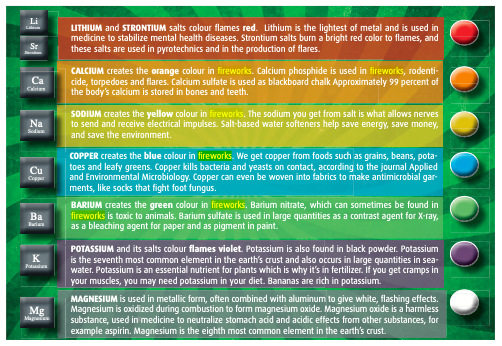
THE SCIENCE OF SPECTACULAR
“What causes the BOOM noise!”
The sonic boom is caused by the sudden release of a large energy mass into the air. The air expands faster than the speed of sound and creates a shock wave. KABOOM!
“What makes the colors happen?”
It’s all about the metal salts. If you throw table salt on a campfire the flame will burn a bright yellow. The chart below explains which compounds are burned to generate blue, red, purple and other colours.
The bright sparkles in fireworks come from burning small bits of iron (FE) filings. Iron is the fourth most
common element in our planet earth’s crust. It’s also cool to know that iron in your blood is what makes your blood able to carry oxygen throughout your body.
“Why are fireworks smoky and smelly?”
Black powder is the activator in most types of firework. It is made of potassium nitrate, charcoal and sulfur. The white smoke that you see in the sky after the firework has exploded is made of water vapor. The combustion heats the water that is present in the air and it vaporizes around the black powder’s potassium and sulfur particulates. The sulfur is what smells likes eggs when it burns.

